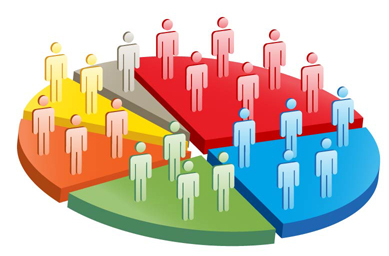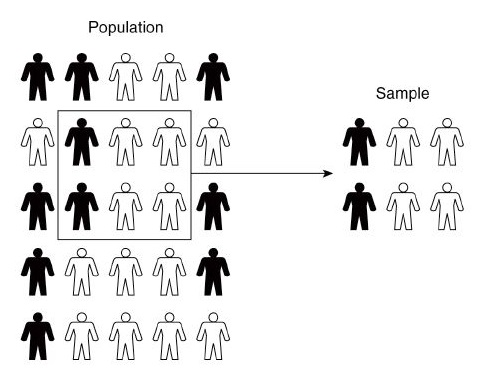A hypothesis is an assumption about relations between variables. It is a tentative explanation of the research problem or a guess about the research outcome. Before starting the research, the researcher has a rather general, diffused, even confused notion of the problem. It may take long time for the researcher to say what questions he had been seeking answers to. Hence, an adequate statement about the research problem is very important. What is a good problem statement? It is an interrogative statement that asks: what relationship exists between two or more variables? It then further asks questions like: Is A related to B or not? How are A and B related to C? Is a related to B under conditions X and Y? Proposing a statement pertaining to relationship between A and B is called a hypothesis. Procedure for Testing Hypothesis To test a hypothesis means to tell (on the Continue reading
Research Techniques
Sampling Methods in Research
Sampling is that part of statistical practice concerned with the selection of an unbiased or random subset of individual observations within a population of individuals intended to yield some knowledge about the population of concern, especially for the purposes of making predictions based on statistical inference. Sampling is an important aspect of data collection. There are two basic approaches to sampling: probabilistic and non-probabilistic sampling. A probability sampling scheme is one in which every unit in the population has a chance (greater than zero) of being selected in the sample, and this probability can be accurately determined. The combination of these traits makes it possible to produce unbiased estimates of population totals, by weighting sampled units according to their probability of selection. Example: We want to estimate the total income of adults living in a given street. We visit each household in that street, identify all adults living there, and Continue reading
Meaning of Sampling and Steps in Sampling Process
Sample and Sampling A Sampling is a part of the total population. It can be an individual element or a group of elements selected from the population. Although it is a subset, it is representative of the population and suitable for research in terms of cost, convenience, and time. The sample group can be selected based on a probability or a non probability approach. A sample usually consists of various units of the population. The size of the sample is represented by “n”. A good sample is one which satisfies all or few of the following conditions: Representativeness: When sampling method is adopted by the researcher, the basic assumption is that the samples so selected out of the population are the best representative of the population under study. Thus good samples are those who accurately represent the population. Probability sampling technique yield representative samples. On measurement terms, the sample must Continue reading
Significance and Problems of Social Research
Significance of Social Research Within the last 20 to 25 years, courses in methods of social research have come to occupy an increasingly important role in sociological curricula. It likely that at present every major university offers such courses. This is because growing significance of social research and also growing job opportunities in this field. The market analysis, the public opinion expert, the investigator of communication and propaganda all are growing facts for governmental and business needs. Knowledge of social research is useful for interpreting and weighing such reports. In the present age, social science are accruing a scientific method of study for this method, research is an important factor. In the last two or three decades, social research has become an important subject of the curriculum of Sociology. In fact almost all the universities, where sociology is taught, social research is a part of the curriculum of the sociology. Continue reading
Social Research – Definition, Steps and Objectives
Definitions of Social Research The term ‘social research’ has been defined by different scholars differently. The few definitions are as follows: Prof. C.A. Moser defined it as “systematized investigation to give new knowledge about social phenomena and surveys, we call social research”. Rummel defined it as “it is devoted to a study to mankind in his social environment and is concerned with improving his understanding of social orders, groups, institutes and ethics”. M.H. Gopal defined it as “it is scientific analysis of the nature and trends of social phenomena of groups or in general of human behavior so as to formulate broad principles and scientific concepts”. Mary Stevenson defined it as “social research is a systematic method of exploring, analyzing and conceptualizing social life in order to extend, correct or verify knowledge, whether that knowledge aid in the construction of a theory or in the practice of an art. A Continue reading
Experimental research and it’s stages
Science revolves around experiments, and learning the best way of conducting an experiment is crucial to obtaining useful and valid results. When scientists speak of experiments, in the strictest sense of the word, they mean a true experiment, where the scientist controls all of the factors and conditions. Real world observations, and case studies, should be referred to as observational research, rather than experiments. For example, observing animals in the wild is not a true experiment, because it does not isolate and manipulate an independent variable. THE BASIS OF CONDUCTING AN EXPERIMENT With an experiment, the researcher is trying to learn something new about the world, an explanation of ‘why’ something happens. The experiment must maintain internal and external validity, or the results will be useless. When designing an experiment, a researcher must follow all of the steps of the scientific method, from making sure that the hypothesis is valid Continue reading


